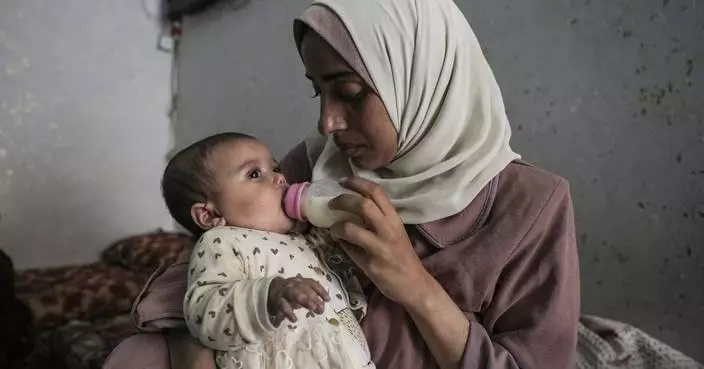Little Amelia Moe was born looking like a “little plastic doll” due to a rare autoimmune disorder called ichthyosis.
A young mum whose baby has skin like a snake was told by medics to bathe the one-year-old in bleach every other day to ward off infection, due to a rare condition which leaves the tot’s skin covered in scales.
Click to Gallery
Little Amelia Moe was born looking like a “little plastic doll” due to a rare autoimmune disorder called ichthyosis.
But retail worker Raven, 23, of Superior, Wisconsin, USA – also a mum to Benjamin Faice, six, and Cole Ford, two – has been criticised for her hygiene routine, saying: “Because Amelia can’t use soap, I put two tablespoons of bleach in her bath water every other day.”
Raven said she and her partner, officer worker Gary Moe, 43 -Amelia’s dad – knew the moment she was born at St Mary’s Medical Centre in Duluth, Minnesota, that something was wrong.
But, the following day, they consulted with a specialist at the University of Minnesota, who confirmed the diagnosis but could not determine at that stage what form of the condition Amelia had.
“I had so many questions, and just needed to know what type she had.”
“We read on some support groups about people with ichthyosis having such thick, tough nails that they need to cut them with plyers, and the skin on the bottom of their feet being so tough they exfoliate with sandpaper. We haven’t had to do that with Amelia though, thankfully.”
Diagnosed with the rare autoimmune disorder lamellar ichthyosis, which sees her skin thicken and shed every couple of weeks, like a snake’s, Raven Ford’s daughter, Amelia Moe, cannot use soap as her skin is so sensitive.
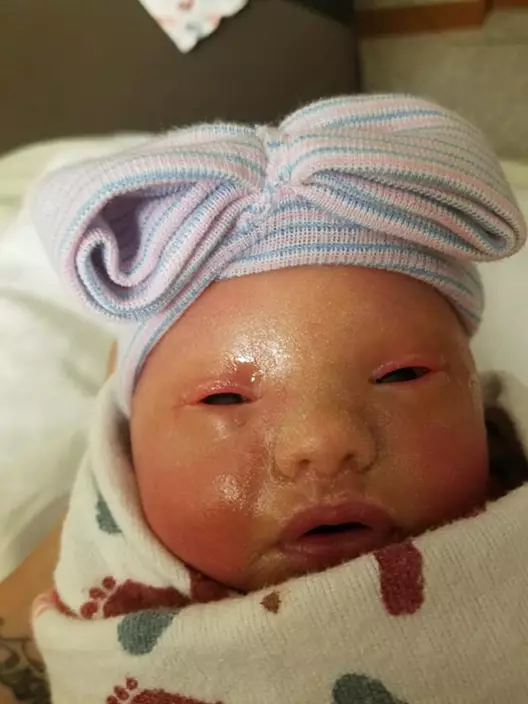
Amelia when she was first born (PA Real Life/Collect)
But retail worker Raven, 23, of Superior, Wisconsin, USA – also a mum to Benjamin Faice, six, and Cole Ford, two – has been criticised for her hygiene routine, saying: “Because Amelia can’t use soap, I put two tablespoons of bleach in her bath water every other day.”
She continued: “It’s controversial, and not everybody is comfortable with it, but it’s been recommended by dermatologists and it’s the only way to kill the bacteria under her scales.
“If we don’t do this, she can get infections or pockets of oil, which show up like yellow bumps on her scalp.”
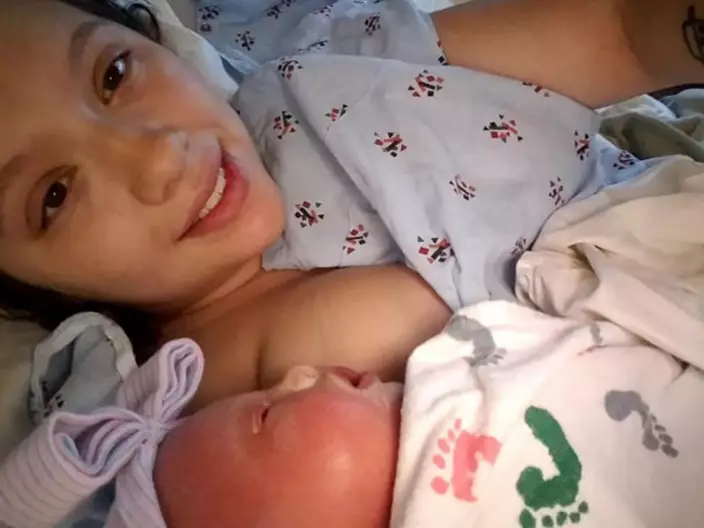
Raven with Amelia when she was first born (PA Real Life/Collect)
Raven said she and her partner, officer worker Gary Moe, 43 -Amelia’s dad – knew the moment she was born at St Mary’s Medical Centre in Duluth, Minnesota, that something was wrong.
She continued: “She looked like a little plastic doll. She had this build-up of really thick skin, which looked very tight and shiny.
“She couldn’t close her mouth or eyes, so doctors weren’t sure at first if she had eyelids, and it covered her hands and feet so much that there were no visible prints.”
As ichthyosis is so rare, medics were initially baffled.
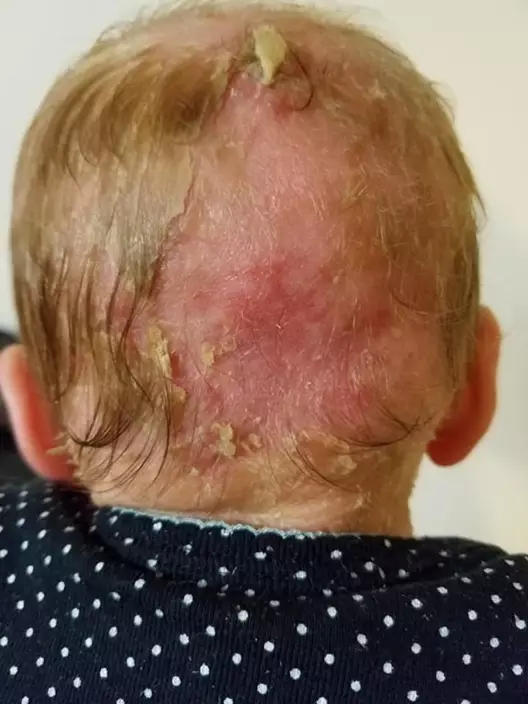
The back of Amelia's head (PA Real Life/Collect)
But, the following day, they consulted with a specialist at the University of Minnesota, who confirmed the diagnosis but could not determine at that stage what form of the condition Amelia had.
There are several different types, all of varying degrees of rarity and severity – the most extreme of which can see babies die shortly after birth.
“The not knowing was the worst feeling in the world,” said Raven. “We were told not to Google ichthyosis, but I couldn’t help myself. I just wanted to know what was happening.”
She continued: “Some forms are really severe and carry quite bleak life expectancies, so it was terrifying thinking Amelia might have to go through that.
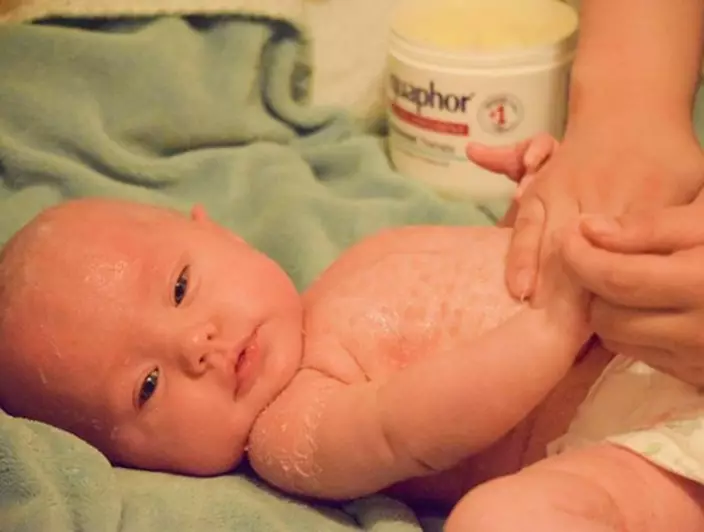
Amelia having lotion applied (PA Real Life/Collect)
“I had so many questions, and just needed to know what type she had.”
While the family is awaiting genetic testing to be completely certain, doctors are now confident Amelia has lamellar ichthyosis which, according to The Ichthyosis Support Group, occurs in approximately one in every 200,000 UK births and is currently incurable.
However, symptoms, including sore, thickened and flaky skin, can be managed using medicinal creams.
For the first 10 days of Amelia’s life, she remained in hospital – during which time her hardened skin began to crack and bleed at her joints, so her parents and a nursing team applied ointments every couple of hours, including Vaseline around her eyes.
“We have to do so much day to day to care for Amelia,” said Raven, who takes her daughter to regular appointments at University of Minnesota Medical Centre to discuss her ongoing needs. “She takes fluoride supplements for her teeth, as we were warned the condition can cause some dental abnormalities.”
She continued: “We also have to put Aquaphor petroleum jelly around her mouth when she eats otherwise the food will stain her skin.
“Her hair is quite brittle and can fall out easily, and her nails have begun to build up and harden too.

Amelia as a newborn baby (PA Real Life/Collect)
“We read on some support groups about people with ichthyosis having such thick, tough nails that they need to cut them with plyers, and the skin on the bottom of their feet being so tough they exfoliate with sandpaper. We haven’t had to do that with Amelia though, thankfully.”
Now, Raven manages Amelia’s symptoms by bathing her twice a day, and keeping her skin constantly topped up with moisturizers and steroid creams.
Where her skin is particularly scaly, she cannot wear certain clothing in case it snags and tears off.
“Anything too loose risks snagging, but anything too tight cuts into her and makes her bleed, so we have to be really careful,” Raven said.
She added: “She’s just started crawling, which causes sores on her knees, so we’re keeping her covered up in trousers made of soft, gentle material.”
As Amelia does not have sweat pores, summer is an especially difficult time.
Mostly, her parents avoid taking her out in scorching temperatures but, if it cannot be avoided, they keep her temperature down with ice packs and a special cooling towel.
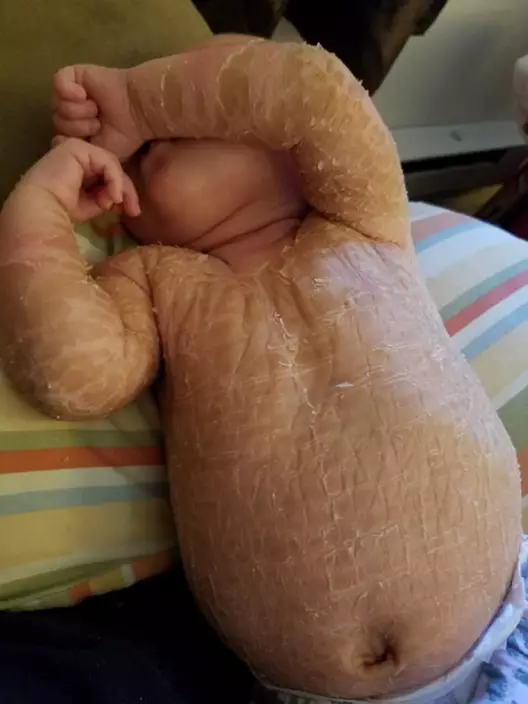
Amelia's torso (PA Real Life/Collect)
Over time, the youngster’s skin has settled into a cycle of building up and shedding.
Raven explained: “She starts out smooth, then her skin gets darker and shinier as it builds up. Eventually, she’ll be unable to close her eyes, at which point we have to start using a type of topical medication called Tazorac cream.
“Then, her skin will start to shed and peel. Thankfully it doesn’t bleed anymore like it did when she was first born.”
Raven continued: “Her hands and feet are largely unaffected, but the peeling on her face takes around a week and the peeling on her scalp takes two.
“Her torso is more or less always scaly, with a texture like you’re petting a snake.”
Sadly, over time, Amelia’s condition has seen Raven subjected to thoughtless comments from strangers.
On a number of occasions, passers-by have told her off after assuming Amelia’s appearance is down to severe sunburn.
And once, shockingly, she said a lady told her she was selfish for wanting more children in case they, too, had the condition.
“That was the most upsetting comment,” said Raven. “I didn’t even know this person. She just butted in with a conversation I was having with a friend.”
“Amelia is such an easy-going child. Yes, we have to do things a little differently, but she is still very happy so it hurts to be called selfish,” Raven added.
“When people do make these comments, I either ignore them or try to educate by explaining what ichthyosis is.”
Speaking for the first time, Raven, who was recently helped by kindly strangers, when she set up a GoFundMe page to help ease the cost of the parts of Amelia’s care not covered by insurance, is keen to raise awareness of the condition.
She is also calling for strangers to be kinder and not to judge people on face value.
She said: “I’d really like people to stop judging things they think are out of the ordinary – especially parenting choices. It’s upsetting when people tell me Amelia is sunburnt, or react negatively when I explain why I buy so much bleach.
“You don’t know what someone is dealing with, or why they are making the choices they are. Everyone has their own reasons – don’t assume it’s all down to bad parenting.”
AUGUSTA, Ga. (AP) — Camilo Villegas wasn't just trying to refine his golf swing as he prepared to play in the Masters for the first time in nine years.
He was constantly checking the fine print on the ingredients in sunscreen. It reached a point a few weeks ago when the 42-year-old Colombian was trying three brands — one for his face, another for his arms, a third for his legs during practice rounds when PGA Tour players can wear shorts.
Nothing is left to chance.
“The first one I realized was more of a cosmetic. It didn't really work as strong as I wanted,” Villegas said. “I'm trying a Korean brand now, and that has worked pretty good.”
Skin cancer has his attention — along with many of his fellow golfers.
There seems to be a renewed emphasis on sun protection. Golfers are more exposed to the sun for longer periods of time than players in any other sport. The weekday rounds last five hours. Throw in an hour of practice before the round, sometimes after, and it adds up quickly.
“The amount of time we spend in the sun, you've got to protect yourself,” Villegas said. “The sun is burning you.”
No need telling Stewart Cink. He was walking off the practice range at Innisbrook Resort in Palm Harbor, Florida, last month when he was asked why sun protection was important to him.
“Well, as someone whose maternal grandmother passed away from melanoma, and someone who's out in the sun a whole lot and someone who already had a big chunk of stuff cut off the side of my face,” he said, pausing to smile. “It very important, not to mention what my wife is going through with her (breast cancer) treatment. It would be dumb not to.”
The American Academy of Dermatology estimates one in five Americans will develop skin cancer. The non-melanoma variety, such as basal cell carcinoma and squamous cell carcinoma, affects 3 million Americans a year.
Sunscreen is just one form of protection.
Stephanie Kyriacou of Australia has always been conscious about the effects of the sun, but a turning point during her amateur days was meeting a woman at home Down Under who invited her to a factory in Queensland.
That was her introduction to Australia-based “SParms,” which makes sun protection sleeves that have become enormously popular on the LPGA Tour.
The sleeves are made of high-tech fabric with an ultraviolet protection factor (UPF) of at least 50, meaning it blocks 98% of the sun's ray. The sleeves can go up the arm and wrap around the shoulder blade.
“Like a lot of girls out here, I'm aware of my skin,” Kyriacou said. “Sunscreen on my face and SParms on my arms. And I like to wear pants unless it's boiling hot.”
Now there are some 60 players at any given tournament wearing sun sleeves.
Kyriacou estimates she's in the sun for at least seven or eight hours a day, and the 23-year-old Aussie has been playing since she was 4.
That's typical of most tour players. They have spent practically their entire lives in the sun, facing the ultraviolet rays that can cause so much damage.
Exposure to the sun’s ultraviolet light raises the risk of skin cancer, the most common and one of the most preventable types of cancer. The American Academy of Dermatology recommends using a sunscreen with a sun protection factor (SPF) of 30 or higher and one that is “broad spectrum,” meaning it protects against both UVA and UVB rays.
“I don't think I wore sunscreen ever,” Cink said. “You know, we use to wear suntan lotion or oil that would intensify the sun so you would get tan. I don't think I wore anything protective at least until I got on tour.”
It wasn't until he was 45 that Cink fully understood the danger. He had a basal cell carcinoma removed from the side of his nose in 2018. And now it's not just any sunscreen he uses.
“I am not a big fan of chemical sunscreen,” he said, referring to the more common brands. “I like the physical barriers, the zinc oxide and titanium dioxide. I look for something that has a high concentration of those two. You can find them if you search.”
Villegas found it on an app called Yuka, which deciphers product labels and analyzes the impact of food and cosmetics. That includes sunscreen.
“It's not perfect. You've got to do some analysis,” Villegas said. “But it gives you options. It's not like it takes you to a website to purchase something — that would make me skeptical. You compare products yourself and do the analysis.”
Skin cancer doesn't discriminate, so golfers of color also are seeking protection.
Xander Schauffele has darker skin, the son of a Taiwanese-born mother and a European father (French and German). He also uses the Yuka app and lately has been going with a product he calls Mr. Seaweed.
“It has less toxic stuff, I've been told by an app,” he said. “Sprays are bad. Cream is the best thing. I look up all that stuff.”
Justin Thomas, a two-time PGA champion whose father and grandfather were club professionals, said he has always used sunscreen, usually whatever is handy. Now he pays closer attention, and for good reason.
He said his legs and neck used to get hit pretty hard by the sun when he was practicing for long hours. He previously had five small moles removed as a teenager. But a tiny one on the back of his left leg concerned him in 2019 because of the odd color.
It turned out to be early stages of melanoma — the most dangerous form of skin cancer but curable if caught early — and he had surgery in which doctors cut down to the fat to make sure they got it all. The surgery left a scar across the back of his calf.
“I was 26 and my doctors are telling me I was months away from being a patient in the hospital,” Thomas said.
He wore sunscreen before. Now he is reading labels, paying particular attention to SPF and getting out the message that “you need to wear sunscreen and you need to get checked.”
AP Medical Writer Carla K. Johnson contributed to this report.
AP golf: https://apnews.com/hub/golf

Camilo Villegas, of Colombia, hits on the practice range during a practice round in preparation for the Masters golf tournament at Augusta National Golf Club Monday, April 8, 2024, in Augusta, Ga. (AP Photo/Matt Slocum)

Camilo Villegas, of Colombia, catches a golf ball on the practice range during a practice round in preparation for the Masters golf tournament at Augusta National Golf Club Monday, April 8, 2024, in Augusta, Ga. (AP Photo/Matt Slocum)
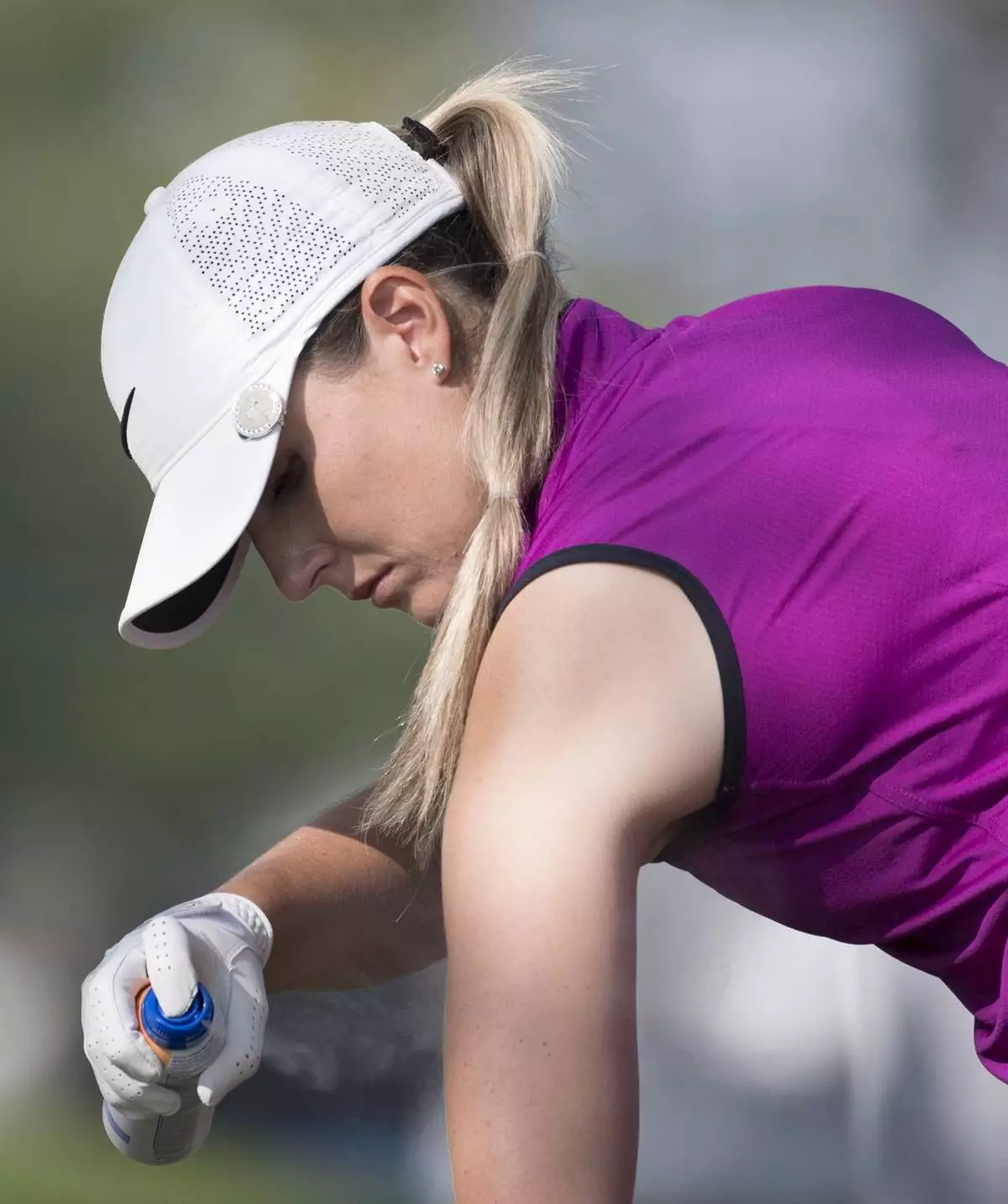
FILE - Megan Osland, of Canada, sprays on sunscreen during the first round of the Women's Canadian Open golf tournament in Regina, Saskatchewan, Thursday, Aug., 23, 2018. Golfers are in the sun as much if not more than players in other sport. It can be as many as eight hours a day. And there is renewed emphasis on protecting their skin. (Jonathan Hayward/The Canadian Press via AP, File)
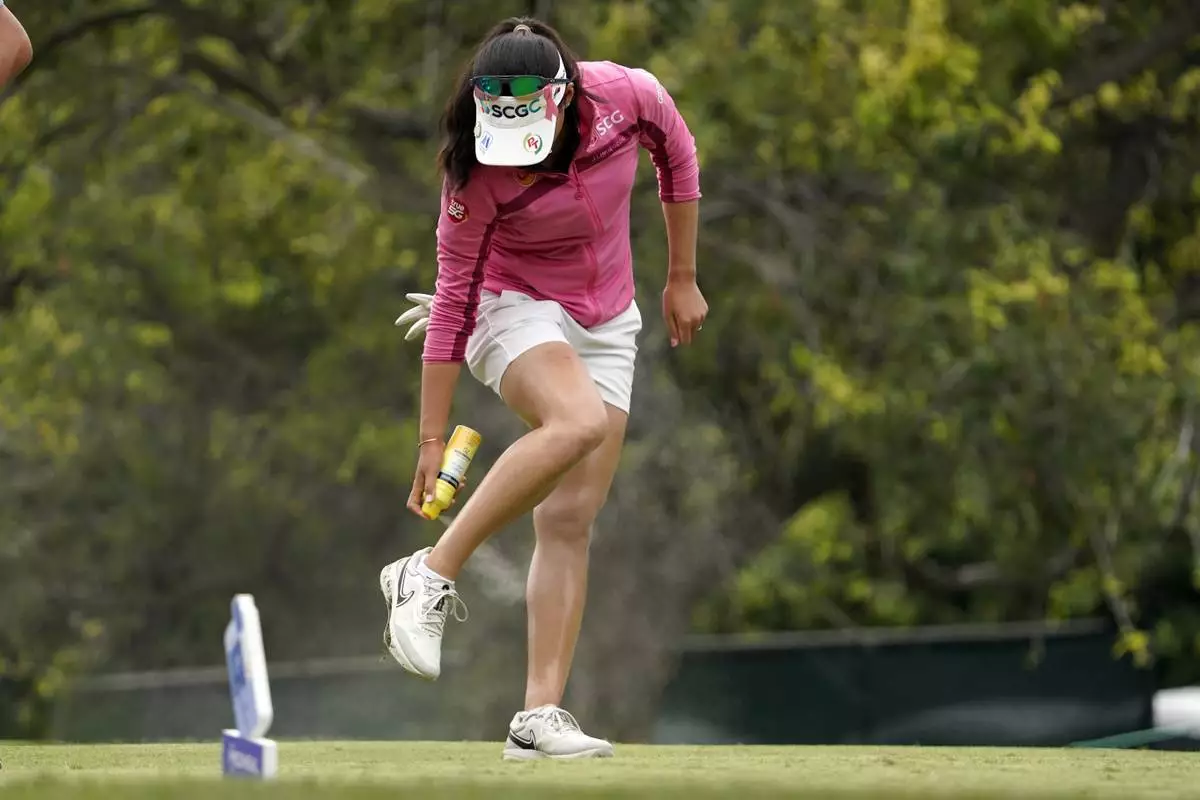
FILE - Atthaya Thitkul, of Thailand, sprays her legs with sunscreen on the third hole during the first round of the MEDIHEAL Championship golf tournament Thursday, Oct. 6, 2022, in Somis, Calif. Exposure to the sun’s ultraviolet light raises the risk of skin cancer, the most common and one of the most preventable types of cancer. (AP Photo/Mark J. Terrill, File)
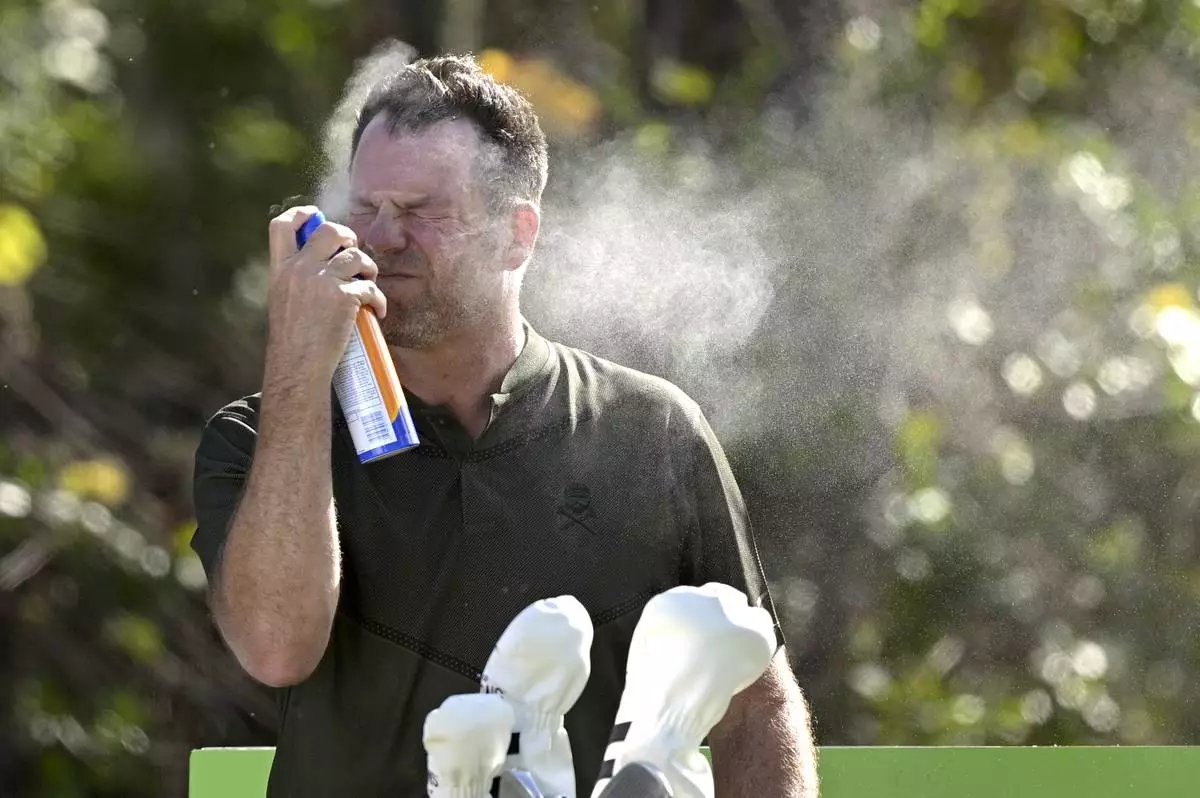
FILE - Mike Flaskey, CEO of Diamond Resorts International, sprays himself with sunscreen before hitting his tee shot on the second hole during the final round of the Tournament of Champions LPGA golf tournament, Sunday, Jan. 24, 2021, in Lake Buena Vista, Fla. (AP Photo/Phelan M. Ebenhack, File)
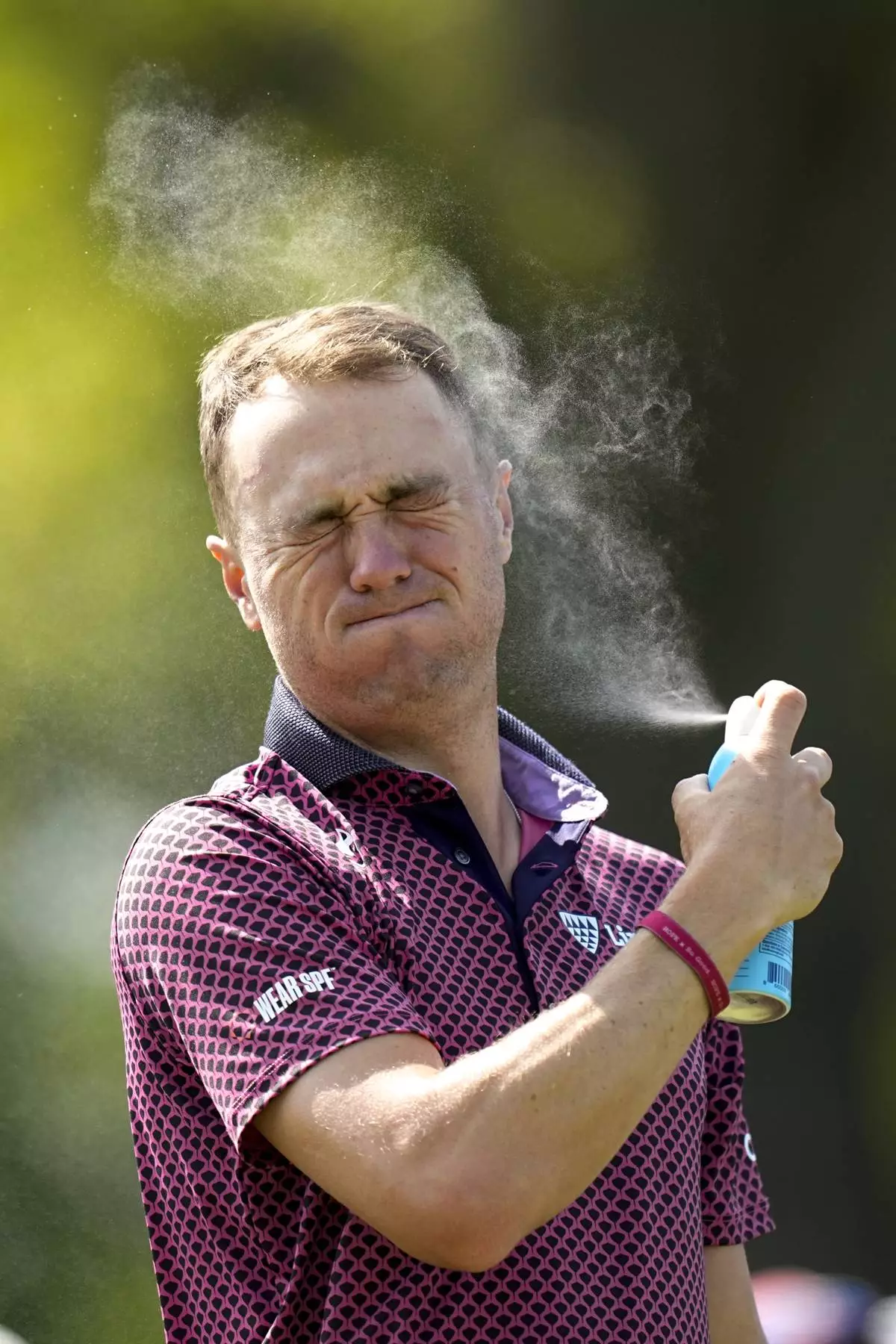
FILE - Justin Thomas applies sunscreen on the 11th hole during the first round of the PGA Championship golf tournament at Oak Hill Country Club on Thursday, May 18, 2023, in Pittsford, N.Y. Thomas, a two-time PGA champion whose father and grandfather were club professionals, said he has always used sunscreen, usually whatever is handy. Now he pays closer attention, and for good reason.(AP Photo/Eric Gay, File)

FILE - Stephanie Kyriacou, of Australia, tees off on the 13th hole during the first round of the ShopRite LPGA Classic golf tournament, Friday, June 10, 2022, in Galloway, N.J. Kyriacou has always been conscious about the effects of the sun. (AP Photo/Matt Rourke)

FILE - Jordan Spieth applies sunscreen during the first round of the SMBC Singapore Open golf tournament at the Sentosa Golf Club's Serapong Course Thursday, Jan. 28, 2016, in Singapore. Golfers are in the sun as much if not more than players in other sport. It can be as many as eight hours a day. And there is renewed emphasis on protecting their skin. (AP Photo/Wong Maye-E, File)
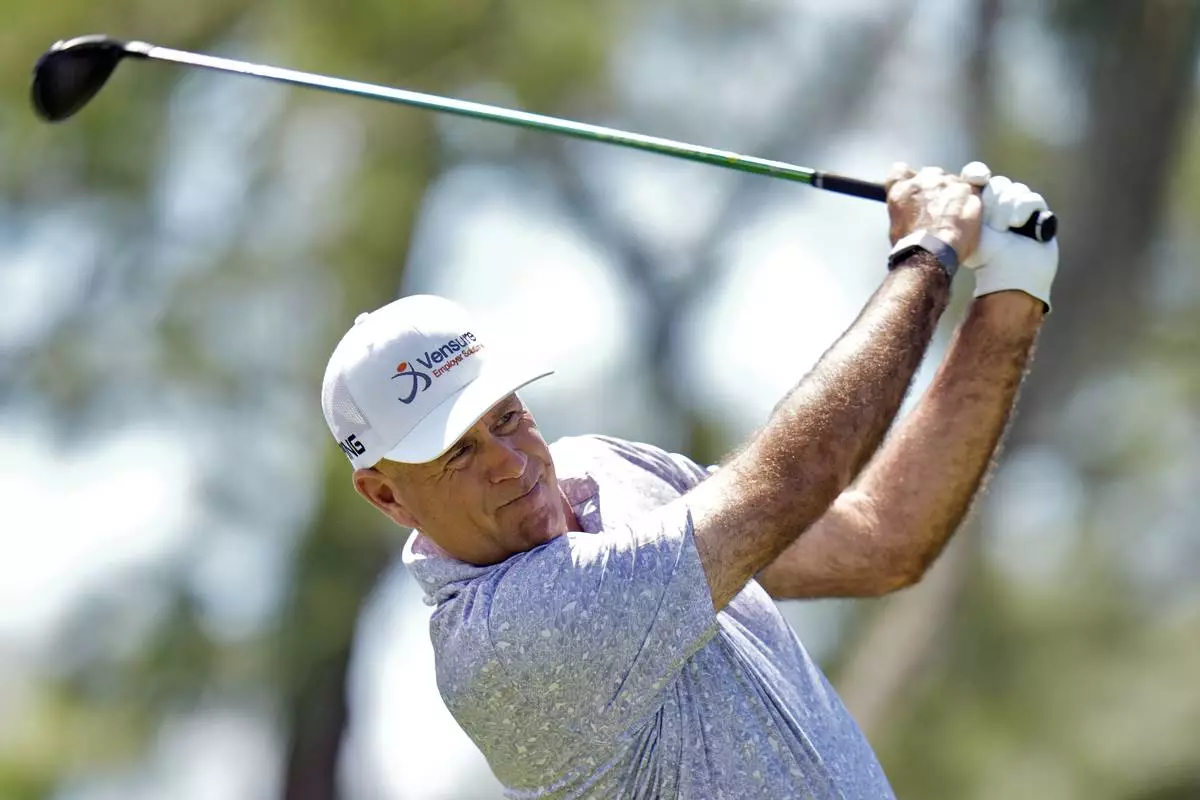
Stewart Cink tees off on the sixth hole during the third round of the Valspar Championship golf tournament Saturday, March 23, 2024, at Innisbrook in Palm Harbor, Fla. Golfers are in the sun as much if not more than players in other sport. It can be as many as eight hours a day. And there is renewed emphasis on protecting their skin. (AP Photo/Chris O'Meara)

Camilo Villegas tees off on the 11th hole during the first round of the Valspar Championship golf tournament Thursday, March 21, 2024, at Innisbrook in Palm Harbor, Fla. Golfers are in the sun as much if not more than players in other sport. It can be as many as eight hours a day. And there is renewed emphasis on protecting their skin. (AP Photo/Chris O'Meara)



















